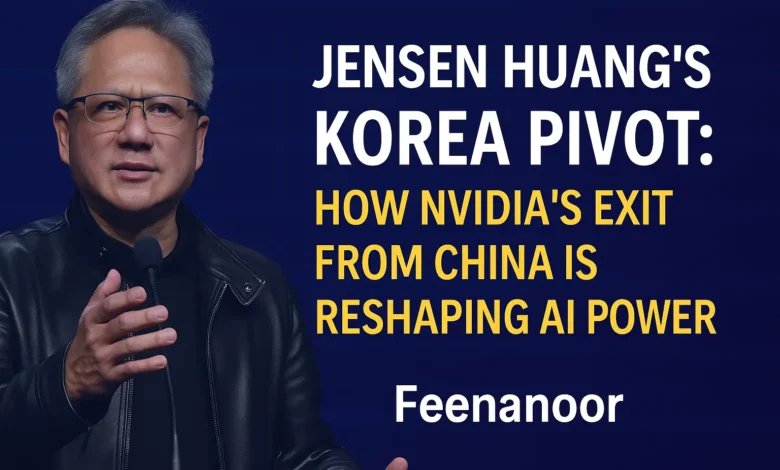Jensen Huang: NVIDIA’s China Exit and the Global Shift in AI Power

Jensen Huang is once again at the center of the global AI debate — not for a product launch, but for a geopolitical shift that could redefine the semiconductor industry.
The NVIDIA CEO revealed this week that his company’s market share in China has fallen from 95% to nearly zero, a direct result of U.S. export restrictions on advanced AI chips.
At the same time, he is turning eastward — toward South Korea, building new alliances that signal a complete reconfiguration of the global AI supply chain.
table of contents
Jensen Huang and the Collapse of NVIDIA’s China Market
For years, China was NVIDIA’s largest overseas market for AI chips, with data centers, startups, and cloud providers running almost entirely on its GPUs.
That dominance came to an abrupt end when the U.S. government imposed new export bans, blocking the sale of high-end models like the H100 and Blackwell series.
Huang’s statement was blunt:
“Our market share in China went from 95% to zero — completely gone.”
This is not a temporary dip. It’s a structural cutoff that leaves a vacuum in one of the world’s fastest-growing AI markets.
But for NVIDIA, this may not be the end — it may be the start of a more strategic realignment.
The Korean Pivot: A New Strategic Axis
During his visit to Seoul this week, Jensen Huang met with top executives from Samsung Electronics and Hyundai Motor Group, exploring partnerships that go beyond graphics chips.
The discussions reportedly covered:
- Next-generation AI accelerators co-developed with Samsung’s foundry division.
- Smart mobility platforms powered by NVIDIA Drive technology.
- Collaborative R&D for edge computing and industrial AI solutions.
This marks a strategic pivot — shifting NVIDIA’s Asia focus from China to South Korea and Japan, where innovation meets favorable trade relations.
💡 Analysts believe this move mirrors the “AI industrial triangle” forming between the U.S., South Korea, and Japan — designed to secure chip supply and limit dependency on China.
Blackwell Chips and the Politics of Export
Huang also confirmed that the company’s Blackwell chips, which power models like GPT-5 and other frontier AIs, are currently barred from being sold to Chinese firms.
However, he added cautiously:
“We hope to eventually supply China again — that decision will be up to President Trump.”
This statement reveals how deeply intertwined AI and geopolitics have become.
NVIDIA’s success is no longer driven purely by innovation, but by policy, diplomacy, and strategic alliances.
Each decision in Washington or Beijing now directly shapes the direction of global AI infrastructure.
The Global Impact: A Shift in AI Supply Power
The consequences of NVIDIA’s China exit ripple far beyond the chip market.
- AI Infrastructure Fragmentation: Chinese firms are rushing to design domestic chips like Huawei’s Ascend series, creating two parallel AI ecosystems.
- Investment Surge in Korea and Japan: These nations are quickly filling the gap, expanding semiconductor manufacturing and R&D partnerships.
- Data Center Realignment: Global cloud providers are redistributing workloads to comply with new export laws — a costly but inevitable process.
By diversifying its alliances, NVIDIA is effectively future-proofing its supply chain — even if that means sacrificing short-term revenue.
Read Also : OpenAI IPO: How a $1 Trillion Valuation Could Redefine the Future of Artificial Intelligence
Jensen Huang’s Leadership: Vision Over Territory
What makes Jensen Huang unique among tech leaders is his adaptability.
He doesn’t just respond to change — he anticipates it.
Under his leadership, NVIDIA transformed from a gaming GPU company into the AI powerhouse driving machine learning, robotics, and even autonomous defense systems.
This latest pivot away from China and toward new global partnerships underscores a consistent principle in Huang’s philosophy:
“Adapt fast or be left behind.”
In the era of AI nationalism, that mindset is not just wise — it’s survival.
The Future of NVIDIA and the AI Industry
The shift to South Korea and the U.S. alliance network suggests a new geography of innovation — one defined not by markets, but by political alignment.
If this model holds, the next generation of AI hardware could be designed within a trusted network of democratic nations, setting the stage for:
- Secure AI development pipelines,
- Ethical AI oversight,
- And long-term technological sovereignty.
For the global AI industry, this is the dawn of a new age: one where semiconductors are as strategic as oil, and leaders like Jensen Huang are the architects of a digital future shaped by policy as much as code.
Jensen Huang has turned a potential crisis into a blueprint for resilience.
By exiting China and deepening alliances with South Korea and global partners, NVIDIA is proving that innovation can thrive even under political pressure.
As the world stands on the edge of an AI-powered century, Huang’s moves are not just corporate strategy — they’re geopolitical chess.
FAQ
1. Why did NVIDIA lose its market in China?
Due to U.S. export bans restricting high-end AI chip sales, particularly the H100 and Blackwell series.
2. What is NVIDIA doing in South Korea?
Building new partnerships with Samsung and Hyundai for chip design, automotive AI, and smart industry solutions.
3. Will NVIDIA return to China?
Possibly, depending on future U.S. trade policy, but not in the short term.
4. What are Blackwell chips?
NVIDIA’s next-generation AI chips designed for large model training, including GPT-5-level workloads.
5. How does this affect the global AI race?
It accelerates regional specialization and strengthens alliances outside China, reshaping global AI infrastructure.
Discover more from Feenanoor
Subscribe to get the latest posts sent to your email.









